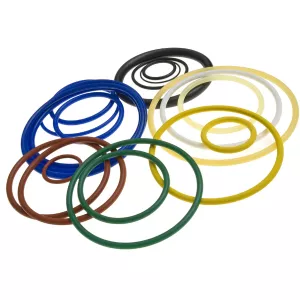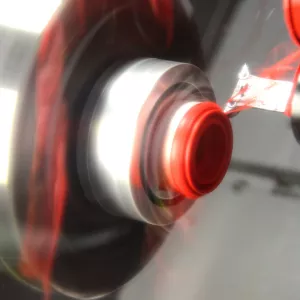A Guide to Seal Materials
Hydraulic seals are used in industrial applications, that prevent a fluid or gas from passing between different components of a cylinder, ensuring that the system operates efficiently and safely. However, not all seals are created equal, and different applications may require different types of seals. In this blog, we discuss the factors to consider when choosing the right seal, that is created in the appropriate material, to best suit your application.
Selecting The Right Seal:
When selecting a hydraulic seal, it's important to consider its material and design, to ensure that it works effectively, safely and reliably.
Temperature:
Temperature is one of the most important factors to consider when selecting seals. The temperature range of the seal must be compatible with the operating environment. If the seal is exposed to temperatures outside of its range, it can fail prematurely.
The temperature range of a seal is determined by the material it is made from. Different materials have different thermal properties. Some materials, such as rubber, are good at sealing at low temperatures, while other materials, such as metal, are better at sealing at high temperatures.
In addition to the operating temperature, the seal must also be able to withstand the temperature fluctuations that may occur in the environment. For example, a seal that is installed in a climate-controlled environment may not be able to withstand the extreme temperatures that can occur outdoors.
High Pressure:
Not all seals can withstand high pressure. Therefore, if you are looking to seal a high-pressure application, it is vital to select a seal in a material that can cope without deforming or breaking. The seal design must be able to create a tight seal without creating too much friction and the seal must be lubricated properly to prevent wear and tear.
Some of the most common types of seals used in high-pressure applications include:
O-rings: O-rings are made of a flexible material that can conform to the surface of the seal housing. They are available in a variety of materials, including rubber, nitrile, and fluorocarbon.
V-rings: V-rings are made of a stiffer material than O-rings and can withstand higher pressures. They are also available in a variety of materials, including rubber, nitrile, and fluorocarbon.
Piston seals: Piston seals are used to seal pistons in cylinders. They are made of a variety of materials, including rubber, nitrile, and fluorocarbon.
Fluid compatibility:
If the seal is not compatible with the fluid used in a hydraulic system, it can degrade the seal material prematurely, causing the seal to leak. When evaluating fluid compatibility numerous factors need to be considered including the chemical composition of the fluid, the operating temperature and pressure, and the seal material. Compatibility will vary dependant on the material type. For example, elastomers are generally compatible with a wide range of fluids, while plastics and metals are more limited in their compatibility.
Different Seal Materials:
Nitrile (NBR)
Properties: Nitrile seals have a good resistance to elongation at break, abrasion and compression set, but their flexibility suffers somewhat in the lower temperature range. Seals made from this material have a low resistance to ozone and must be stored carefully in most environments.
Temperature: Nitrile can withstand temperature range from -30°C to +100°C
Fluid Compatibility: The most common nitrile copolymer blend is the compound known as Buna-N. Possessing very good resistance to petroleum based hydraulic oils, Buna-N also works well with fuels such as diesel or gasoline.
PTFE
Properties: PTFE has chemical inertness, high heat resistance, low temperature flexibility, low running friction, and non-adhesive characteristics. Because of a lack of resilience (memory) in PTFE, an energizer is most often employed to obtain the desired fit. Most PTFE seals, to retain their toughness and flexibility, are fortified with short glass fibres, bronze flashes, carbon graphite, or a combination of these fillers.
Temperature: PTFE can withstand temperatures to over 300°C but are often reduced by the filler or energizer employed.
Fluid Compatibility: PTFE seals are compatible with most chemicals, including acids, bases, and solvents.
Ethylene-Propylene (EPDM)
Properties: Ethylene-Propylene (EPDM) has good heat resistance, low compression set and good flexibility at low temperatures.
Temperature: Ethylene-Propylene temperature ranges between -45°C and +150°C .
Fluid Compatibility: Ethylene-Propylene can be used for sealing phosphate ester hydraulic fluids such as Skydrol but is not suitable for petroleum based fluid. Ethylene-Propylene is highly effective for use with steam, acetone, and dilute acids and bases. Specially compounded Ethylene-Propylene can be made suitable for automobile brake systems.
Polyurethane (AU)
Properties: Polyurethane is highly resistant to oil swell, ozone, oxidation, abrasion and has excellent cut resistance. Highly resilient, urethanes also have high tensile strength and elongation properties. Formulated of copolymers of ether or ester based urethanes, this material is used in a wide application of seals, wipers, backup rings, cushions, bumpers, and a myriad of other uses.
Temperature: Most urethane seals remain flexible and efficient in temperatures ranging between -54°C and +93°C with some able to withstand intermittent temperatures up to +135°C.
Fluid Compatibility: Polyurethane is compatible with hydraulic systems using petroleum based fluids.
Silicone (VMQ)
Properties: Silicone is an elastomer made from silicon, oxygen, hydrogen, and carbon. It has a high resistance to dry heat, ultraviolet light, and ozone. This material is not recommended for dynamic situations due to poor abrasion resistance and high friction characteristics.
Temperature: Silicone temperature ranges from -54°C to +204°C
Viton® - FPM / Viton® equivalent FKM
Properties: Viton® - FPM / Viton® equivalent FKM combines high temperature resistance with excellent chemical resistance. This material is not recommended for use in low temperatures or in aircraft hydraulic fluids.
Temperature: Viton® - FPM / Viton® equivalent FKM temperature ranges is -20° to +400° F.
Fluid Compatibility: Excellent for use with alcohol and aromatic fuels and highly resistant to ultraviolet light and ozone.
PolyEther Ether Ketone (PEEK)
Properties: PEEK has excellent strength, fatigue resistance and stability in high temperature environments, with a melting point around 343°C, and very good chemical resistance.
Temperature: PolyEther Ether Ketone (PEEK) recommended operating temperature is -54°C up to +260°C
Fluid Compatibility: PEEK is compatible with almost any of the solvents used in HPLC.
Hydrogenated Nitrile Butadiene Rubber (HNBR)
Properties: Hydrogenated Nitrile is also known as saturated Nitrile have excellent resistance to many modern fuels, resistance to high energy radiation & good abrasion resistance.
Temperature: Hydrogenated Nitrile Butadiene Rubber (HNBR) temperature ranges from -40°C to +150°C
Fluid Compatibility: HNBR is widely used in automotive and oil industries and maintains excellent resistance to motor oils, sour gas, amine/oil mixtures, oxidized fuels, and lubricating oils. HNBR is resistant to mineral oil-based hydraulic fluids, animal and vegetable fats, diesel fuel, ozone, sour gas, dilute acids, and bases.
Ultra high molecular-weight polyethylene (UHMWPE)
Properties: UHMWPE (Ultra High Molecular Weight Polyethylene) has very long molecular chains that helps to transfer load more effectively, strengthening intermolecular interactions. This results in a very tough material, with the highest impact strength of any thermoplastic presently made. It has very high abrasion resistance, shows zero water absorption, is self-lubricating and has a friction coefficient only slightly above most filled PTFE.
Temperature: Ultra high molecular-weight polyethylene (UHMWPE) recommended operating range is -200°C up to just +80°C
Fluid Compatibility: UHMWPE is stable in all hydraulic fluids, with high resistance to acids, bases, and aggressive media.
Selecting the right seal material is crucial to ensure the efficient and safe operation of machines, devices, and systems. Not sure what you are need? Get in touch with our knowledgeable team here at FPE Seals, who will discuss your requirements based on your application, and help you find the right seal for the job.



